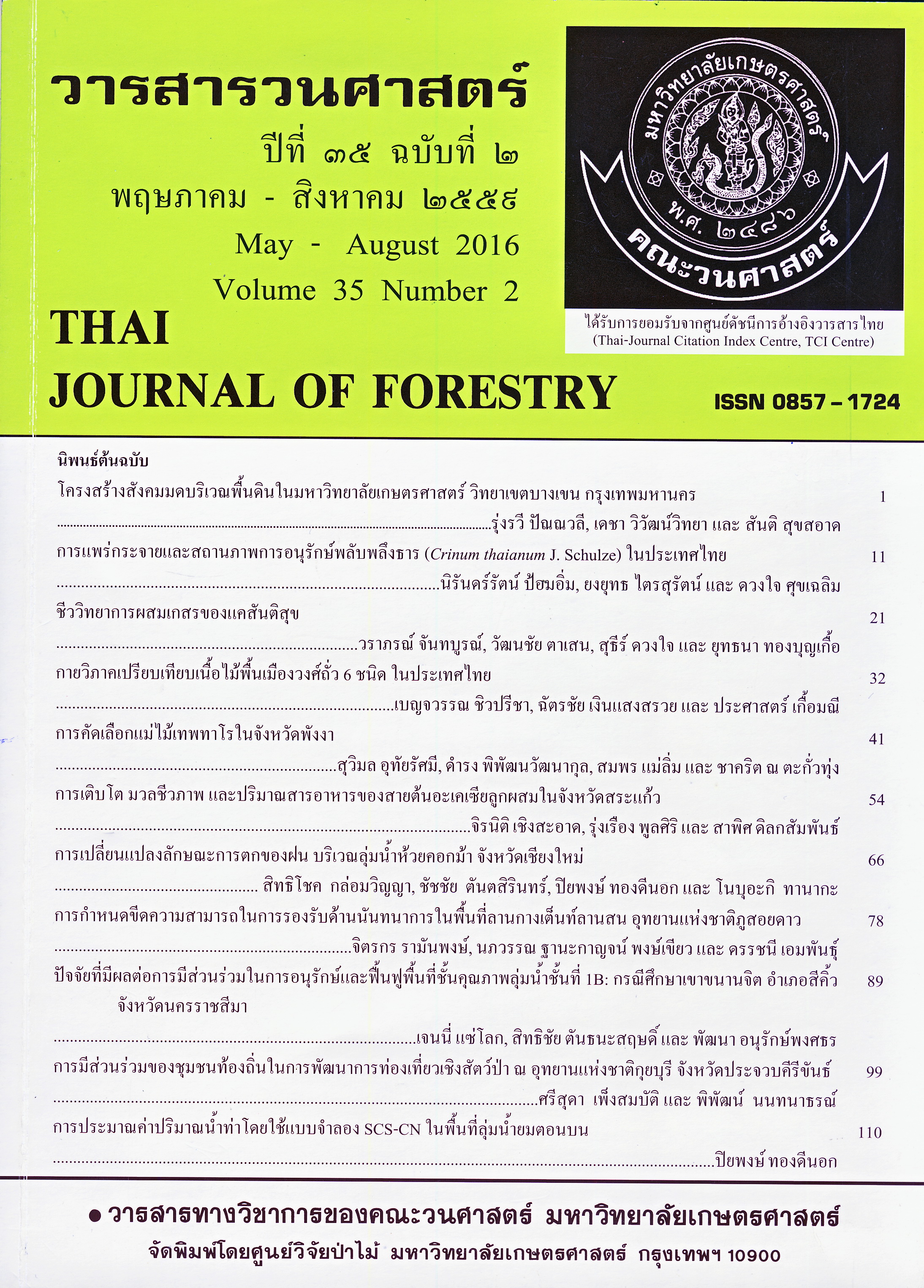การเติบโต มวลชีวภาพ และปริมาณสารอาหารของสายต้นอะเคเซียลูกผสม ในจังหวัดสระแก้ว
Main Article Content
บทคัดย่อ
การเติบโต มวลชีวภาพ และปริมาณสารอาหารของสายต้นอะเคเซียลูกผสมที่ปลูกในจังหวัดสระแก้ว ได้ทำการศึกษาโดยวางแผนการทดลองแบบสุ่มในบล็อกสมบูรณ์ (randomized complete block design; RCBD) ในแปลงปลูกไม้อะเคเซียลูกผสม อายุ 4 ปี โดยมีระยะปลูก 3×3 เมตร จำนวน 4 บล็อก บล็อกละ 6 สายต้น ในแต่ละสายต้นปลูก จำนวน 24 ต้น ได้แก่ สายต้น 1, 3, 5, 14, 18 และ 19
ผลการศึกษาพบว่า การเติบโตของขนาดเส้นผ่านศูนย์กลางที่ระดับชิดดิน เส้นผ่านศูนย์กลางเพียงอก และความสูงมีมากที่สุดในสายต้น 14 และน้อยที่สุดในสายต้น 18 ส่วนอัตราการรอดตาย สายต้น 3, 5 และ 14 มีค่ามากที่สุด และน้อยที่สุดในสายต้น 18 และ 19 ขณะที่มวลชีวภาพเหนือพื้นดิน สายต้น 1 มีค่ามากที่สุด (76.22 ตันต่อเฮกตาร์) และสายต้น 18 มีค่าน้อยที่สุด (18.88 ต้นต่อเฮกตาร์) นอกจากนี้ความเข้มข้นของแคลเซียมในส่วนของลำต้นและกิ่งมีค่ามากที่สุด รองลงมาคือ ไนโตรเจน โพแทสเซียม ฟอสฟอรัส และแมกนีเซียมน้อยที่สุด ขณะที่ส่วนของใบมีความเข้มข้นของแคลเซียมมีค่ามากที่สุด รองลงมาคือ ไนโตรเจน โพแทสเซียม แมกนีเซียม และฟอสฟอรัสน้อยที่สุด
ปริมาณการสะสมอาหารในส่วนของลำต้น และกิ่ง มีแนวโน้มเหมือนกัน คือ ปริมาณแคลเซียมมีค่ามากที่สุด รองลงมาคือ ไนโตรเจน โพแทสเซียม ฟอสฟอรัส และแมกนีเซียมน้อยที่สุด ขณะที่ในส่วนของใบการสะสมของแคลเซียมมีค่ามากที่สุด รองลงมาคือ ไนโตรเจน โพแทสเซียม แมกนีเซียม และฟอสฟอรัส
Downloads
Article Details
ข้าพเจ้าและผู้เขียนร่วม (ถ้ามี) ขอรับรองว่า ต้นฉบับที่เสนอมานี้ยังไม่เคยได้รับการตีพิมพ์และไม่ได้อยู่ในระหว่างกระบวนการพิจารณาตีพิมพ์ลงในวารสารหรือสิ่งตีพิมพ์อื่นใด ข้าพเจ้าและผู้เขียนร่วม (ถ้ามี) ยอมรับหลักเกณฑ์และเงื่อนไขการพิจารณาต้นฉบับ ทั้งยินยอมให้กองบรรณาธิการมีสิทธิ์พิจารณาและตรวจแก้ต้นฉบับได้ตามที่เห็นสมควร พร้อมนี้ขอมอบลิขสิทธิ์ผลงานที่ได้รับการตีพิมพ์ให้แก่วารสารวนศาสตร์ คณะวนศาสตร์ มหาวิทยาลัยเกษตรศาสตร์ กรณีมีการฟ้องร้องเรื่องการละเมิดลิขสิทธิ์เกี่ยวกับภาพ กราฟ ข้อความส่วนใดส่วนหนึ่ง หรือ ข้อคิดเห็นที่ปรากฏในผลงาน ให้เป็นความรับผิดชอบของข้าพเจ้าและผู้เขียนร่วม (ถ้ามี) แต่เพียงฝ่ายเดียว และหากข้าพเจ้าและผู้เขียนร่วม (ถ้ามี) ประสงค์ถอนบทความในระหว่างกระบวนการพิจารณาของทางวารสาร ข้าพเจ้าและผู้เขียนร่วม (ถ้ามี) ยินดีรับผิดชอบค่าใช้จ่ายทั้งหมดที่เกิดขึ้นในกระบวนการพิจารณาบทความนั้น”
เอกสารอ้างอิง
Attanandana, T. and J. Chancharoensook. 1999. Soil and Plant Analysis. Department of Soil Science, Faculty of Agriculture, Kasetsart University, Bangkok.
Department of Information Technology and Communications. 2015. About Province. Available Source: http://www.sakaeo.go.th/websakaeo/location.php, June 9, 2015.
Division of Soil Survey and Soil Resources Research, Land Development Department. 2015. Nong Takhian Bon Subdistrict, Watthana Nakhon District, Sa Kaeo Province. Available Source: http://oss101.ldd.go.th/web_thaisoilinf/east/Sakaew/sak_map/sk_man62/2705/270510_home.html, July 8, 2015.
Evans, J. 1979. The effects of leaf position and leaf age in foliar analysis of Gmelina arborea. Plant Soil 52: 547-552.
Haruthaithanasan, M., K. Haruthaithanasan, A. Thanawat, S. Phromlert and A. Baysangchan. 2010. The potential of Leucaena leucocephala, Eucalyptus camaldulensis, Acacia mangium and Acacia spp. (mangium x auriculaeformis) as plantation crops for energy, pp. 579-586. In Proceedings of 48th Kasetsart University Annual Conference: Plants. Kasetsart University, Bangkok.
Jackson, M.L. 1958. Soil Chemical Analysis. Prentice-Hall, Inc., Englewood Cliffs.
Kha, L.D., N.D. Hai, H.H. Thinh, P.V. Tuan and L.B. Thinh. 2005. Clonal Tests of Natural Hybrids at Ba Vi, Yen Thanh and Bau Bang (Report for Registration New Varieties). Forest Science Institute of Vietnam, Vietnam.
Kietvuttinon, B. and P. Tiyanon. 1997. Production of 1.5 m x 2 m and 2 m x 4 m spacings of acacias plantations at Prachuab Kiri Khan province. Research paper. Silvicultural Research Division, Forest Research Bureau, Royal Forest Department, Bangkok. (in Thai)
Kira, T. and T. Shidei. 1967. Primary production and turnover of organic matter in difference forest ecosystems of the Western Pacific. Jap. Ecol. 17 (2): 70-87.
Kumar, R., K.K. Pandey, N. Chandrashekar and S. Mohan. 2011. Study of age and height wise variability on calorific value and other fuel properties of Eucalyptus Hybrid , Acacia auriculiformis and Casuarina equisetifolia. Biomass and Bioenergy 35 (3): 1339-1344.
Lamb, D. 1977. Relationships between growth and foliar nutrient concentrations in Eucalyptus deglupta. Plant Soil 47: 495-508.
Luangviriyasaeng, V. 2013. Economic Fast-Growing Tree Improvement for Farmer and Community. Forest Research and Development Bureau, Royal Forest Department, Bangkok. (in Thai)
Luangviriyasaeng, V., K. Pinyopusarerk, K. Pitpreecha, A. Simsiri and B. Kiatvuttinand. 1995. Early growth of Acacia auriculiformis progeny trials. Thai J. For. 14: 81-93.
Peawsa-ad, K. and C. Viriyabuncha. 2002. Growth, yield and aboveground biomass of Acacia mangium willd. Research paper. Silvicultural Research Division, Forest Research Bureau, Royal Forest Department, Bangkok. (in Thai)
Poolsiri, R. 1997. Effect of Stand Density on Tree Form, Growth Rate and Yield of 12 Year-Old Eucalyptus camaldulensis Dehnh. M.S. Thesis, Kasetsart University.
Rotchanametakul, P. 1998. Provenance Variation in Growth Performances, Leaf Nitrogen Contents and Stomatal Conductances of Acacia auriculiformis A. Cunn. ex Benth. M.S. Thesis, Kasetsart University.
Satoo, T. and M. Senda. 1958. Materials for the studies of growth in stand. IV. Amount of leaves and production of wood in young plantation of Chameacyparis obtusa. Bull. Tokyo Univ. For. 54: 7-100.
Singh, V. and O.P. Toky. 1995. Biomass and net primary productivity in Leucaena, Acacia and Eucalyptus, short rotation, high density ('Energy') plantation in arid India. J. Arid Environ. 31: 301-309.


